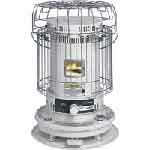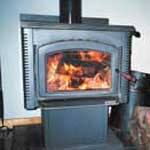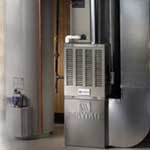WINTER FIRE SAFETY TIPS FOR THE HOME
The high cost of home heating fuels and utilities have caused many Americans to search for alternate sources of home heating. The use of wood burning stoves is growing and space heaters are selling rapidly, or coming out of storage. Fire places are burning wood and man made logs. All these methods of heating may be acceptable. They are however, a major contributing factor in residential fires. Many of these fires can be prevented. The following fire safety tips can help you maintain a fire safe home this winter.
KEROSENE HEATERS
- Be sure your heater is in good working condition. Inspect exhaust parts for carbon buildup. Be sure the heater has an emergency shut off in case the heater is tipped over.
 Never use fuel burning appliances without proper room venting. Burning fuel (coal, kerosene or propane, for example) can produce deadly fumes.
Never use fuel burning appliances without proper room venting. Burning fuel (coal, kerosene or propane, for example) can produce deadly fumes.- Use ONLY the fuel recommended by the heater manufacturer. NEVER INTRODUCE A FUEL INTO A UNIT NOT DESIGNED FOR THAT TYPE FUEL.
- Keep kerosene, or other flammable liquids stored in approved metal containers, in well ventilated storage areas, outside of the house.
- NEVER fill the heater while it is operating or hot. When refueling an oil or kerosene unit, avoid overfilling. DO NOT use cold fuel, as it may expand in the tank as it warms up.
- Refueling should be done outside of the home (or outdoors).
- Keep young children away from space heaters—Especially when they are wearing night gowns or other loose clothing that can be easily ignited.
- When using a fuel burning appliance in the bedroom, be sure there is proper ventilation to prevent a buildup of carbon monoxide.
WOOD STOVES AND FIREPLACES
Wood stoves and fireplaces are becoming a very common heat source in homes. Careful attention to safety can minimize their fire hazard. Although proper maintenance, cleaning, and care should reduce the chance of a chimney fire, it’s always smart to be prepared. To use wood stove and fireplaces safely:
 Be sure the fireplace or stove is installed properly. Wood stoves should have adequate clearance (36”) from combustible surfaces, and proper floor support and protection.
Be sure the fireplace or stove is installed properly. Wood stoves should have adequate clearance (36”) from combustible surfaces, and proper floor support and protection.- Replace the batteries in your home’s smoke and carbon monoxide detectors annually. Check your fire extinguishers on a regular basis and recharge or replace them if necessary.
- Have the chimney inspected and cleaned annually. The Ponderosa Pine wood found in our area can create a lot of soot, ashes and creosote that build up in the chimney. When this residue gets hot it can easily catch fire.
- Wood stoves should be of good quality, solid construction and design, and should be UL (Underwriter’s Laboratory) listed.
- Do not use flammable liquids to start or accelerate any fire.
- Keep a glass or metal screen in front of the fireplace opening, to prevent embers or sparks from jumping out, unwanted material from going in, and help prevent the possibility of burns to occupants.
- Never burn charcoal indoors. Burning charcoal can give off lethal amounts of carbon monoxide.
- Keep flammable materials away from your fireplace mantel. A spark from the fireplace could easily ignite these materials.
- Before you go to sleep, be sure your fireplace fire is out. NEVER close your damper with hot ashes in the fireplace.A closed damper will help the fire to heat up again and will force toxic carbon monoxide into the house.
- If synthetic logs are used, follow the directions on the package. NEVER break a synthetic log apart to quicken the fire or use more than one log at a time. They often burn unevenly, releasing higher levels of carbon monoxide.
- IF YOU SUSPECT (OR KNOW) THAT YOU HAVE A CHIMNEY FIRE:
- Call the Fire Department by dialing 911.
- Never try to remove burning logs from your fireplace. Use water or a fire extinguisher to put them out. Fire extinguisher is best. Be careful with putting water on the fire. On one hand, the steam created with a glass or two of water may put out the fire – or at least cool it down significantly. However, there is a possibility that the sudden cooling could crack any glass door/screen, or cause damage to mortar or other components. Ask a certified fireplace inspector or consult your factory stove / fireplace manual.
- If you suspect a chimney fire, get everyone out of the house immediately and call the fire department. If you can do so safely, put out any fire in the stove or fireplace and close the damper. (Some fast-burning chimney fires produce dense smoke and flames shooting out the top of the chimney, often accompanied by a rumbling sound inside the chimney. Slow-burning chimney fires are much harder to detect but can also cause serious damage to the chimney and, possibly, to the house.)
- If you suspect that you have had a chimney fire, do not use the fireplace again until a chimney sweep has checked it for any hidden damage.
FURNACE HEATING
- Be sure all furnace controls and emergency shutoffs are in a proper working condition.

- Leave furnace repairs to qualified specialists. Do not attempt repairs yourself unless you are qualified.
- Inspect the walls and ceiling near the furnace and along the chimney line. If the wall is hot or discolored, additional pipe insulation or clearance may be required.
- Check the flue pipe and pipe seams. Are they well supported, free of holes, and cracks? Soot along or around seams may be an indicator of a leak.
- Is the chimney solid, with cracks or loose bricks? All unused flue openings should be sealed with solid masonry.
- Keep trash and other combustibles away from the heating system.
OTHER FIRE SAFETY TIPS
- Never discard hot ashes inside or near the home. Place them in a metal container outside and well away from the house.
- Never use a range or an oven as a supplemental heating device. Not only is it a safety hazard, it can be a source of potentially toxic flumes.
- If you use and electric heater, be sure not to overload the circuit. Only use extension cords which have the necessary rating to carry the amp load. TIP: Choose an extension cord the same size or larger than the appliance electrical cord.
- Avoid using electrical space heaters in bathrooms, or other areas where they may come in contact with water.
- Frozen water pipes? Never try to thaw them with a blow torch or other open flame, (otherwise the pipe could conduct the heat and ignite the wall structure inside the wall space). Use hot water or a UL labeled device such as a hand held dryer for thawing.
- If there is a fire hydrant near your home you can assist the fire department by keeping the hydrant clear of snow so in the event it is needed, it can be located.
FINALLY…
- Be sure every level of your home has a working smoke alarm, and be sure to check and clean it on a monthly basis.
- Plan and practice a home escape plan with your family.
- Contact the Groom Creek Fire District for advice if you have a question on Home Fire Safety.

You must be logged in to post a comment.